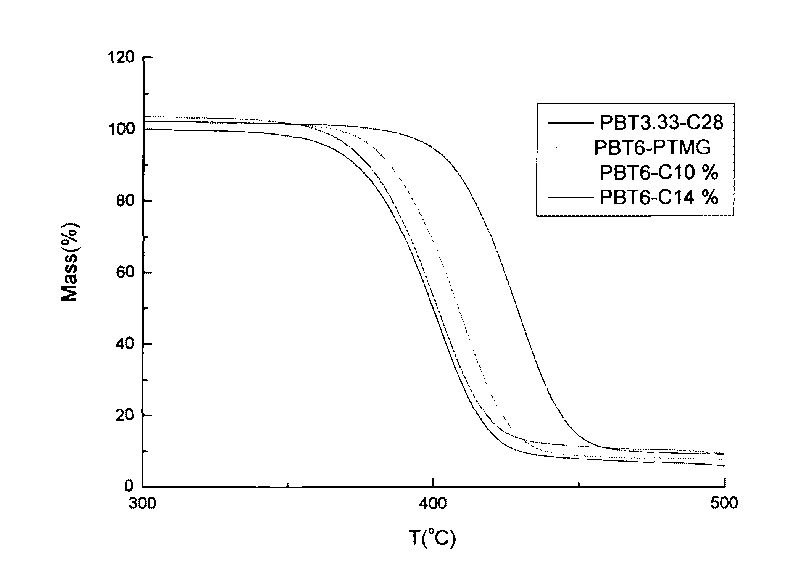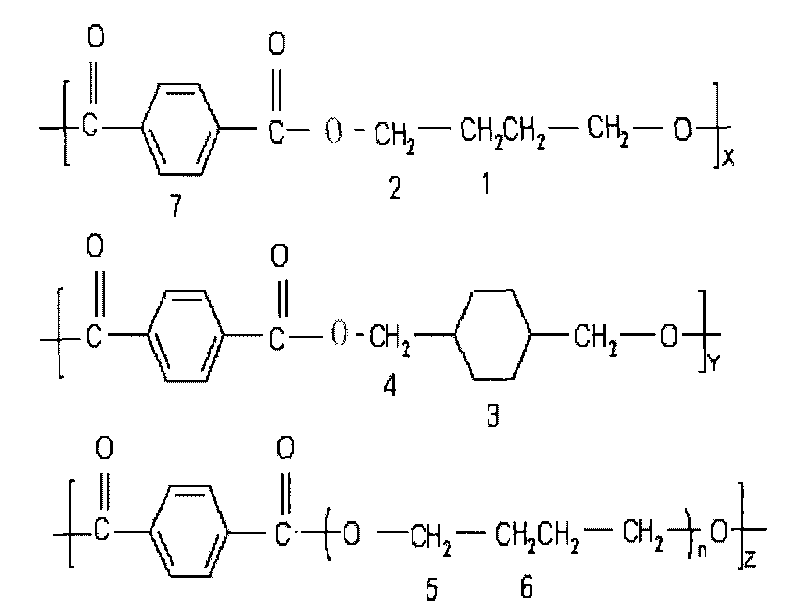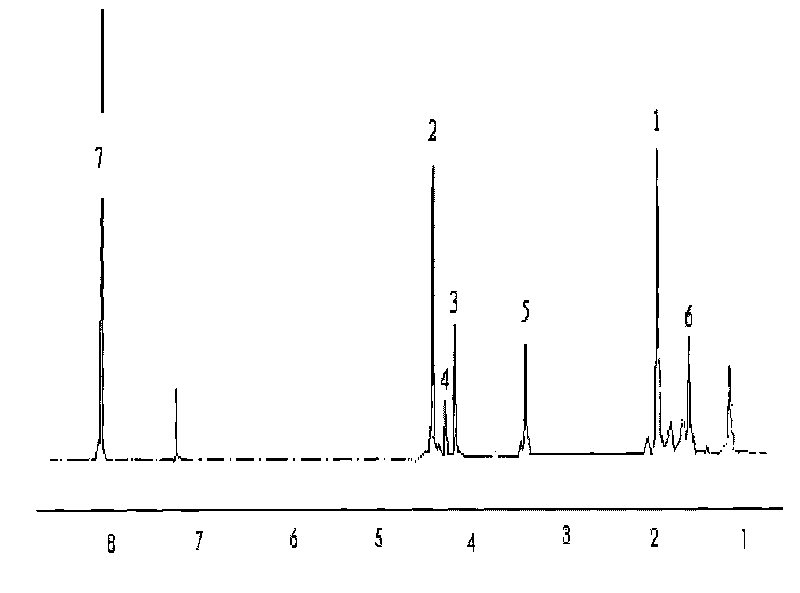Thermoplastic block copolyether ester elastomer and preparation method thereof
A technology of block copolymerization and copolyetherester, which is applied in the field of copolyetherester elastomer and its preparation, can solve the problems of high processing temperature, melting point of copolyetherester higher than 220°C, difficult processing, etc., and achieve excellent processing performance and melting point And the effect of crystallization rate reduction and physical property change
- Summary
- Abstract
- Description
- Claims
- Application Information
AI Technical Summary
Problems solved by technology
Method used
Image
Examples
Embodiment 1
[0037] First weigh 970 grams of dimethyl terephthalate (DMT), 720 grams of 1,4-butanediol (BG), 108 grams of polytetramethylene ether glycol (PTMG, molecular weight 1000, 1% total binary Alcohol mole fraction), 144 g 1,4-cyclohexanedimethanol (CHDM, 10% total glycol mole fraction), 50 ppm tetrabutyl titanate, 3065 ppm antioxidant. Add part of dimethyl terephthalate (DMT) powder into the 5L reaction kettle equipped with inlet and outlet, nitrogen inlet, condenser, stirrer and fractionation column, turn on the heating and add the remaining materials into slurry. Gradually rise from room temperature to the range of 180-220°C, keep the temperature at the top of the fractionation column at 63-65°C, and when the amount of by-product methanol distilled out of the reaction kettle reaches more than 90% of the theoretical amount, start to reduce the pressure and heat up, and reduce the temperature in about 40 minutes. The pressure is reduced below 150Pa, while the temperature rises to 2...
Embodiment 2
[0039]First weigh 1000 grams of dimethyl terephthalate (DMT), 695 grams of 1,4-butanediol (BG), 111 grams of polytetramethylene ether glycol (PTMG, molecular weight 1000, 1% total binary Alcohol mole fraction), 370 g 1,4-cyclohexanedimethanol (CHDM, 25% total glycol mole fraction), 15 ppm tetrabutyl titanate, 40 ppm zinc acetate, 300 ppm antioxidant. Add part of dimethyl terephthalate (DMT) powder into the 5L reactor equipped with inlet and outlet, nitrogen inlet, condenser, agitator and fractionation column, turn on the heating, and then add the remaining materials into slurry . Gradually rise from room temperature to the range of 180-220°C, keep the temperature at the top of the fractionation column at 63-65°C, and when the amount of by-product methanol distilled out of the reaction kettle reaches more than 90% of the theoretical amount, start to reduce the pressure and heat up, and reduce the temperature in about 40 minutes. The pressure is reduced below 150Pa, while the t...
Embodiment 3
[0041] First weigh 970 grams of dimethyl terephthalate (DMT), 630 grams of 1,4-butanediol (BG), 108 grams of polytetramethylene ether glycol (PTMG, molecular weight 1000, 1% total binary Alcohol mole fraction), 432 grams of 1,4-cyclohexanedimethanol (CHDM, 30% total glycol mole fraction), 32ppm tetrabutyl titanate, 10ppm zinc lactate, 2625ppm antioxidant. Add dimethyl terephthalate (DMT) powder into a 3L reaction kettle equipped with inlet and outlet, nitrogen inlet, condenser, stirrer and fractionation column, turn on the heating, and then add the slurry made of the remaining materials into . Gradually rise from room temperature to the range of 200-220°C, keep the temperature at the top of the fractionation column at 63-65°C, and when the amount of by-product methanol distilled out of the reactor reaches more than 90% of the theoretical amount, start to reduce the pressure and heat up, and reduce the temperature in about 40 minutes. The pressure is reduced below 130 Pa, whil...
PUM
 Login to View More
Login to View More Abstract
Description
Claims
Application Information
 Login to View More
Login to View More - R&D
- Intellectual Property
- Life Sciences
- Materials
- Tech Scout
- Unparalleled Data Quality
- Higher Quality Content
- 60% Fewer Hallucinations
Browse by: Latest US Patents, China's latest patents, Technical Efficacy Thesaurus, Application Domain, Technology Topic, Popular Technical Reports.
© 2025 PatSnap. All rights reserved.Legal|Privacy policy|Modern Slavery Act Transparency Statement|Sitemap|About US| Contact US: help@patsnap.com



